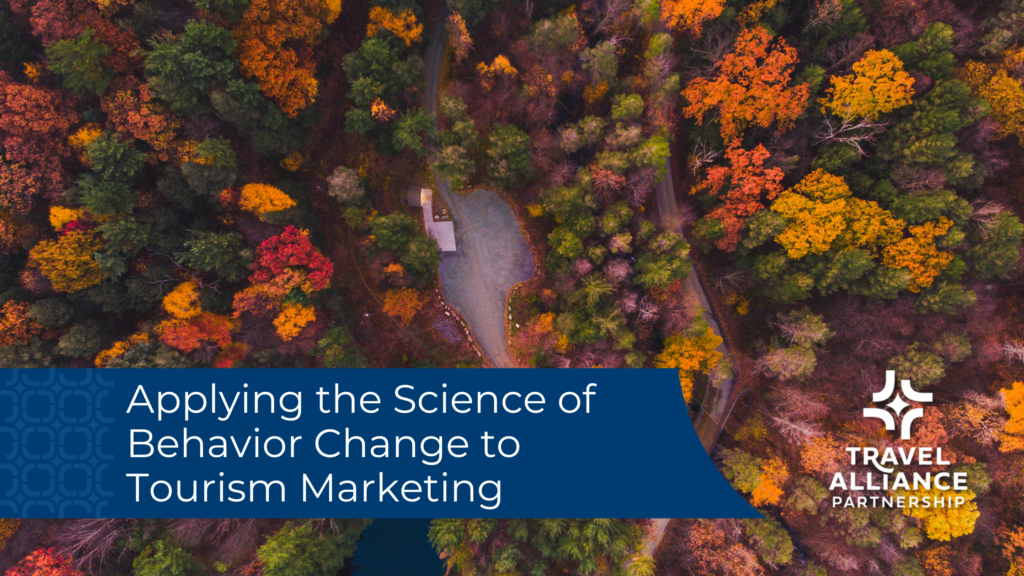Applying the Science of Behavior Change to Tourism Marketing
Through our work on a marketing campaign to create behavior change and promote sustainability, we started with research to understand the best way to inspire change in behavior. I found a five-concept theory presented in a report on boaters’ environmental views and a six-step theory of change published by conservation organization Rare and combined them to form seven steps. These seven steps, or components, are a key part of how we can inspire sustainable tourism through our marketing efforts. Whether you are looking to inspire behavior change for a sustainable tourism initiative, a social program or a community development project, use these seven principles to guide your strategy and messaging.

Read our introduction to capacity building in communities for destination development.
1. Awareness
As with any marketing campaign, awareness is the first step. In the case of sustainable or ecological tourism, we’re raising awareness of the issues in addition to raising awareness of the brand or program. Awareness stems not only from reach, impressions and the frequency of a message, but also the clarity and simplicity of the message.
2. Why?
Give reasons why the issues are a concern. Inform consumers on the why behind the initiative or concern to gain their buy-in. Beyond being aware, now they are included in the information they need to understand. Providing additional context helps bring people with you. It’s also an opportunity to impart a feeling of goodwill by bringing them into a greater cause.
3. Demonstrate the impact
If we’re trying to change behaviors, then there are measurable impacts to the behaviors we don’t want. The cost of inaction is what we need to convey at this step. Provide real examples! How is overtourism impacting the environment? Are invasive species affecting crops or the ability to enjoy recreational areas?
4. Shareability
Create messaging that allows easy sharing and promotes discussion on social media. Involve the audience in growing your audience. Incentives big and small help in sharing a message of sustainability. Whether it’s simply asking your audience to share the message, providing small prizes or even running a larger contest, there are many strategies you can employ to encourage sharing.
5. What
Make sure the audience knows what to do, with helpful details to make it simple. Just as our tourism marketing requires clear calls to action, sustainability efforts need the same. Tell them what you want them to do for sustainability efforts. May we suggest a few #lifehacks? Break down the the actions to take to make them easy to follow, and easy to do. This is another point where people may be drawn to be part of something greater.
6. Barrier removal
Understanding what is standing in the way of the desired behavior is a key point in behavior change. Something may be preventing people from taking action. Until we collect information and feedback from the audience, we may never know what those things are. If direct feedback isn’t possible, set up measurement and tracking in a way that you can make an educated guess. Better yet, participate yourself or create a focus group with your team or colleagues who can give you feedback. Talk to the people – frontline staff, hosted media, friends and family – anyone who can help you find insights on what will make the actions easier to do.
7. Make a difference
Show people that they are making a difference when they participate. Share some or all of your analytics in a public, meaningful way that encourages people to continue. It can also encourage new people to engage. Demonstrating progress made inspires hope and provides more proof of the issue at hand.
In the end, consumers need more than information; they need to understand the issues, the tools to share, simple steps to action and proof their actions make a difference.
Related Posts
How Curated Experiences Can Help Your Tourism Marketing
In years past, travelers may have been satisfied to see sites like the Eiffel Tower or Colosseum; now they want to get behind the scenes,...
From Assistant to Amplifier: Rethinking AI for Tourism Marketers
After attending MAICON, a Marketing AI conference hosted by SmarterX, one message came through loud and clear: AI isn’t replacing marketers—it’s making our work sharper,…
